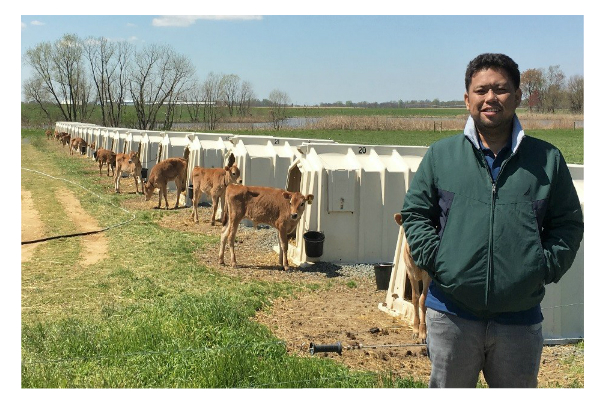
|
|
|
It's that time of the year when we embrace the spooky and the weird. October is the month when we dress in outfits we've painstakingly created in our heads all year. It is that special time when we get to meet witches, ghosts, mummies and the like on the street without feeling the urge to run in the opposite direction.
Before your houses are surrounded in tissue paper, the pumpkin carving starts and the candy shopping rush begins, your Continental Search family would like to wish you a Spooktacular Halloween! We hope you have a fun one!
If you have any fun pictures of your pets or farm animals all decked out in their Halloween finest, send them over! We'd love to feature you on our page! You can send them to maria@consearch.com. Have a fun and spooky All Hallow's Eve!
Antibiotics vs. Antibiotic-Free Poultry: What is the Difference?
I went to the National Meeting on Poultry Health, Processing, and Live Production recently. It was held in Ocean City, and it ran through September 28 to 30. I had the privilege to listen to informative and useful talks that I believe will help me understand this industry even more.
One of the most interesting seminars had to do with antibiotic-free vs. antibiotic use in poultry. On the 28th, Dr. Randy Mitchell of Perdue Foods, LLC talked about the use of probiotics. On the 29th, Dr. David French of Sanderson Farms discussed the use of antibiotics in poultry, while Dr. Chuck Hofacre of the University of Georgia talked about raising chickens without the use of antibiotics.
Dr. Mitchell's talk started with a definition of both probiotics and antibiotics. According to FAO/WHO, probiotics are live microorganisms that confer health benefits when administered in adequate amounts. Antibiotics, on the other hand, are substances that can destroy or weaken certain microorganisms, like bacteria and fungi that cause infectious diseases. These are usually produced by synthesizing other microorganisms, like molds.
Probiotics are given via oral route and through hatchery spray. It is used to prevent disease, maintain intestinal microflora, immune response, for antimicrobial activity and competitive exclusion. They differ from antibiotics, which are delivered via topical application, oral route, and through injection. Antibiotics are used to treat and prevent disease. They can act in the GIT or system.
There are challenges with both programs. In Chuck Hofacre's talk, he mentioned the challenges that antibiotic-free producers face. Feed changes at the wrong time can lead to disaster. Higher protein early on can lead to increased chances of necrotic enteritis. Lastly, the ABF program can clash with animal welfare programs.
With regard to poultry raised on antibiotics, the obstacles are different. The main hurdle is how marketing has influenced the public. It is apparent that the major concern of the consumer is antibiotic resistance. This means that consumers are more likely to buy a chicken that is raised ABF in comparison to those raised the traditional way.
Are the use of antibiotics in livestock really bad? There is no set answer, according to UDel. First off, animals who get antibiotics in their feed gain about 4 to 5% more body weight than those who do not. Shelf life is extended in poultry, eggs, and even meat. Livestock live longer and are not carriers of dangerous diseases like salmonella, as well.
Then there are also cons of antibiotic use. The first one we should address is multidrug-resistant pathogens. There are documented cases of high-resistant Salmonella strains caused by the use of high-dose antibiotics. There is the MRSA virus to consider, as well.
Dr. French of Sanderson Farms also mentioned that it is a DVM's duty to adhere to the Veterinarian's Oath. He also notes that both the FDA and many veterinarians approve of antibiotics, as it allows them to "do the right thing" for the animals.
At the end of the day, there is no wrong or right way to raise chickens. It all boils down to the producer and what he or she feels is the best program to work with given current budget, environment, and desired goals. However, one thing is for certain: why debates regarding this matter might rage on, the poultry industry is expanding to meet higher demands.
This means that there will be more jobs in the future for people who are currently part of this industry and for those who are still about to enter it. Even so, success will depend on being privy to industry networking, as well.
This is why we urge individuals in the poultry industry to follow #ContinentalSearch on Facebook and LinkedIn. With over 15 years in this industry, we have helped place many deserving candidates into positions that have improved their career paths. Let us do the same for you. If you want to know about what poultry job opportunities we have for your specific skillset, please send me an email.
TRISH VALENZUELA, CPC - Recruiter
Trish Valenzuela specializes in recruiting for poultry feed additive companies. S he has filled positions in technical support, sales, and sales management across the USA.
Trish joined Continental Search in July 2015, and through hard study, she passed two certification programs. She is now a Certified Personnel Consultant (CPC) and a Professional Recruiting Consultant (CPR). he has filled positions in technical support, sales, and sales management across the USA.
Trish joined Continental Search in July 2015, and through hard study, she passed two certification programs. She is now a Certified Personnel Consultant (CPC) and a Professional Recruiting Consultant (CPR).
Send your resume to trish@consearch.com or call her at (302) 248-8242. Visit her
LinkedIn profile to connect with her and stay updated with current poultry trends. Trish can be reached at (302) 248-8242, through LinkedIn, or at trish@consearch.com.
The Quest to Save the Greater Sage Grouse
The greater sage grouse is otherwise known as Centrocercus urophasianus. This is the largest grouse in North America. It was also considered to be endangered a few years ago. In this article by Judith Kohler on the National Wildlife Federation's Blog, she discusses how far people are going to help this species survive.
Photo by Pacific Southwest Region from Sacramento, US (Greater Sage-Grouse) [CC BY 2.0 (http://creativecommons.org/licenses/by/2.0)], via Wikimedia Commons
This is said to be the largest conservation effort in US history. It covers 173 million acres and 10 states. The plan contains input from both state and local governments. The ultimate goal is to save sagebrush lands as it is home to the greater sage grouse and species, including pronghorn, elk, golden eagles, and the mule deer.
The habitat of the greater sage grouse has been depleted throughout the years. Once at 16 million in number, they depleted to about 200,000 to 500,000. Their lands have been taken away by the development of subdivisions, energy development, wildfires, drought, agriculture, and overgrazing.
The greater sage grouse is a regal creature. Adults have a long and pointed tail with feathers on their toes. Males have a yellow patch over their eyes, black belly, dark brown throat, and a white breast. What sets them apart is the yellow sacs on their neck that resemble breastplates. These puff up during a display of courtship. The females are mottled grayish brown with a light brown throat and exhibit a dark belly.
Luckily, as of September 22, 2015, they are not considered endangered anymore. We have to thank the efforts of the Bureau of Land Management and U.S. Forest Service for dev eloping a strategy to save the sagebrush steppe, which is the habitat of the greater sage grouse. eloping a strategy to save the sagebrush steppe, which is the habitat of the greater sage grouse.
Sadly, the battle is not yet over. You may read the full article here to find out what challenges the conservationists still face and help them by joining their cause.
Maria Codilla
Maria Codilla is the Content Manager for Continental Search. She writes about pet health, wildlife, and advances in the animal sciences. For comments and topic suggestions, you can reach her at maria@consearch.com.
Hydroponics in the Dairy Industry
The Feed Navigator published an interesting article that will appeal to dairy producers facing problems with drought. This article is about Golden Valley Farms and how they decided to move towards hydroponic growing to combat drought-related problems.
The dairy farm began growing barley sprout feed inside in 2013. Since then, they have expanded their production, according to Mario Daccarett, the owner.
He also said that they wanted to increase conjugated linoleic acid levels in milk produced by their dairy cows. This was done by using only fresh feed. Hydroponics has allowed them to apply stringent quality control measures.
At present, the dairy makes use of a ration of oat hay and fresh barley sprouts. They raise both ingredients. The barley sprouts took the place of the alfalfa they once used.
This system has allowed them to reduce the amount of water required for feed growth. They use just 2% of the water they did when farming the traditional way. The system they use is commercially available.
While it is relatively new and still going through an evolution of sorts, it is undeniable how much it has helped them save. Feeding many animals has become more affordable. The substitution of barley sprout instead of alfalfa increased their savings, as it is a lot cheaper.
Since the new feed is more digestible, there is less manure. This means that animals get more of the feed's nutrients out through the milk instead of their feces. Therefore, that translates to higher-quality milk for the consumers.
Innovation is the key to success, especially when it translates into greater savings and better product. If you are in the dairy industry or contemplating this field for a future business venture, you will want to consider applying this to your endeavor.
This is just one of the many new innovations in dairy nutrition. I'll keep posting articles like this every few weeks. By the way, if you are looking for a job in this field, Continental Search has a wide array of openings in the dairy industry. If you need help in choosing one that suits your skill set best, do not hesitate to email me for assistance.
Rick Pascual, CPC/PRC
Rick Pascual recruits in dairy nutrition for feed companies and their suppliers across the USA. Rick joined Continental Search in January 2015 and has successfully filled a number of searches for nutritionists, sales, and sales management for leading companies. across the USA. Rick joined Continental Search in January 2015 and has successfully filled a number of searches for nutritionists, sales, and sales management for leading companies.
After completing coursework and a grueling exam, Rick became a Certified Personnel Consultant (CPC) in November 2015, as well as a Certified Professional Recruiter (CPR) by AIRS in April 2016. Visit his LinkedIn profile for more info and to stay updated with news about recent dairy trends.
Training in Black and White: Zari's Story
San Diego's Animals in Action program would not be complete without the black and white stripes. These belong to Zari, a seven-year old zebra who does meet and greets with children and adults during special tours and events. This article by the San Diego Zoo talks about how they turned a skittish zebra foal into one of their most sought-after ambassadors.
Zebras are known to be skittish creatures, so it is amazing how she is able to entertain guests without becoming aggressive or running off. Zari is trained and handled by Charmaine, who says that positive reinforcement and patience helped mold beautiful Zari into the charming zebra she is today.
Just a little over a year old when Zari came to the San Diego Zoo, she grew up raised by her mother. Charmaine thinks this is rare, as most animal ambassadors are hand raised by the staff, making it easier for them to get used to being around lots of people.
The skittish new arrival was put under the care of lead hospital keeper, Tom Sica. He was able to gain her trust, as he had to tend to her hooves. Working with Kathy Carmack, an animal training supervisor, Zari finally went through the process of halter training.
Charmaine finally got to work with Zari when the zebra joined the Animals in Action team. Slowly she was able to add to Zari's repertoire. It starts with teeth rasping, which is otherwise called floating. This a process that is necessary for overall health and well-being.
The molars of a zebra and other equine species can grow continuously. When the cusps grow too long, there is a danger that they might puncture the soft tissue and lead to infection. This causes discomfort and physical distress.
One of the first things they did was get her to open her mouth. She was compensated with a treat each time, making it a pleasant experience. After some time, Zari would open her mouth when she heard the word "open." She was soon rewarded for keeping her mouth open for longer periods.
The next step was to introduce a piece of metal into her mouth. The goal was to be able to file her teeth without putting her under sedation. After many tries, Zari finally allowed the process to take its course. This weekly routine helps keep her happy and healthy, which affects her demeanor around guests.
Zari's presence inspires awe. Her beautiful pattern and gentle demeanor stuns both young and old visitors. As an ambassador, Zari's job is to make people feel the urge to protect wildlife from extinction. While she cannot talk, Zari's presence alone speaks loudly enough.
Are you in the equine industry? I was wondering how often you file your horses' teeth. Does it affect their demeanor and overall well-being? 
You can view the full article from San Diego Zoo here. For comments and suggestions for future articles, get in touch with me at maria@consearch.com.
Maria Codilla
Maria Codilla is the Content Manager for Continental Search. She writes about pet health, wildlife and advances in the animal sciences. For comments and topic suggestions, you can reach her at maria@consearch.com.
Ultrasound Technology Simplifies Pregnancy Testing in Cattle
Recently Beef Magazine published an article on an important technological advancement that ranchers can utilize. This informative article shows the advantages of using ultrasound technology to make pregnancy checks easier.
In the past, most ranchers would have to palpate to find out if their cattle were pregnant. This sometimes proved to be inaccurate, and it was hard to tell how old the fetus was. These days, this process has become a lot easier, thanks to ultrasound technology. It provides beef producers with more accurate fetal aging and pregnancy diagnosis. This leads to tighter calving groups, less open cows in the springtime, and the ability to detect reproductive diseases earlier, as well as possible reproductive anomalies.
Ultrasound technology has evolved. At present, it is easier to use and more affordable, which is good news for veterinarians and producers.
The convex rectal probe from ReproScan Veterinary Ultrasound Technology has been around since 2009 and is the first of its kind. This allows a larger field view than outdated linear probes. Therefore, it make fetus aging easier to accomplish.
Notice that it comes with extension arm technology, making it easier for ranchers and ranch hands. It is simple enough for new users to operate, after trying it on a few cows.
The Reproscan's Reproarm lets operators do the task in a fast and efficient manner. This reduces stress in cattle and humans. It also saves time, as well. Even smaller ranches are incorporating it into their business endeavor because it provides accuracy, allows them to check about 100 heads of cattle in an hour, and is cost-effective. Here is a video that will help people understand how this technological advancement simplifies the process.
If you're in the beef industry and considering career options, let Continental Search assist you in finding a job that will help your career grow and send me an email.
DAN SIMMONS, CPC, Sr. Recruiter

As Owner of Continental Search, Dan leads a team of four recruiters who search for talented leaders and solo contributors to fill positions for feed companies and their suppliers.
Dan Simmons has 25 years of experience recruiting and has worked in the animal nutrition industry since 2002. As owner of Continental Search, his firm has helped hundreds of professionals find positions that advanced their careers. Visit Dan's LinkedIn profile for more information and relevant updates regarding the animal science industry.
|
| |
Copyright © 2016 Animal Science Monitor, All rights reserved. |
| |
animalsciencemonitor.com |
|
|
|
|
|
|
|
